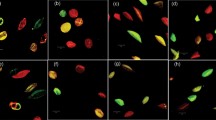Abstract.
CD99, the product of the MIC2 gene, exhibits an erythroid-specific quantitative polymorphism co-regulated with the Xga blood group polymorphism. The co-expression of X-linked MIC2 and XG genes is presumably controlled at the transcriptional level by a single XGR locus in the pseudoautosomal region of sexual chromosomes. This locus is composed of two alleles, XGR low and XGR high, which determine low or high CD99 levels (CD99-L, CD99-H) and the Xg(a–)/Xg(a+) status. To test this hypothesis, the phenotypic relationship between Xga and CD99 antigens on human RBCs was investigated by quantitative flow cytometry using NBL-1 (anti-Xga) and 12E7 (anti-CD99) monoclonal antibodies and semi-quantitative estimate of membrane proteins and RNA by Western blot and Northern blot, respectively. The antibody binding capacity of RBCs, which is an estimation of the antigen density, was determined for 118 blood donors including 60 males and 58 females. Xg(a+) RBCs, which all belong to the group of CD99-H expressors, carry 159±13 and 960±50 copies of Xga and CD99 molecules/cell, respectively. Xg(a–) RBCs have no Xga antigen, but are subdivided into CD99-H (all male) and CD99-L expressors carrying 747±28 and 200±22 CD99 copies/cell, respectively, with identical CD99 levels between CD99-L males and females. However, among males, the CD99 expression was higher in Xg(a+) than in Xg(a–)/CD99-H individuals (P<0.01). In addition, CD99-H expressors in Xg(a+) males could be clearly subdivided into two categories, high and super high expressors, which are presumably heterozygous and homozygous for the XGR high allele, which fits the above hypothesis. This was not the case for Xg(a+) females where CD99-H subcategories were not found. Quantitative differences were confirmed by Western blot analysis of red cell membrane preparations from individuals of different Xga and CD99 phenotypes and by Northern blot analysis showing that the reticulocytes from CD99-L individuals expressed a reduced level of MIC2 transcripts compared to CD99-H donors. These findings further support the hypothesis of a single genetic control of CD99 and Xga expression by the XGR locus.
Similar content being viewed by others
Author information
Authors and Affiliations
Additional information
Electronic Publication
Rights and permissions
About this article
Cite this article
Fouchet, C., Gane, P., Cartron, JP. et al. Quantitative analysis of XG blood group and CD99 antigens on human red cells. Immunogenetics 51, 688–694 (2000). https://doi.org/10.1007/s002510000193
Received:
Revised:
Issue Date:
DOI: https://doi.org/10.1007/s002510000193




